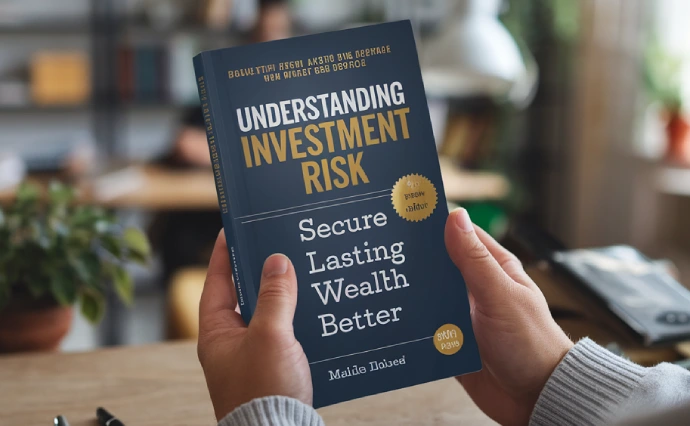Understanding Investment Risk
Investment risk is an important topic for anyone who wants to grow their money through investing. When you invest, there is always a chance that things might not go as planned. This is known as Understanding investment risk. In this section, we will explain what investment risk means, why it matters, and introduce some of the different types of risks you might face when investing.
What is Understanding Investment Risk?
Investment risk means the possibility of losing some or all of the money you invest. When you put your money into an investment, like stocks or bonds, you expect to earn a return. However, things don’t always go as planned. Sometimes, investments can lose value instead of gaining. This is because different factors, such as market changes, economic conditions, or company performance, can affect the value of your investment.
Every investment comes with some level of risk. It’s important to understand this risk before making any decisions. Even though the idea of losing money can be scary, risk is part of investing, and it’s something investors need to manage wisely.
Why is Investment Risk Important?
Understanding investment risk is crucial because it helps you make smart decisions about where and how to invest your money. Without understanding the risks, you might make decisions that lead to big losses. On the other hand, when you understand the risks, you can choose investments that match your financial goals and your comfort level with risk.
For example, some people are willing to take higher risks because they want higher returns. These investors might invest in stocks, which can be very risky but offer the potential for large gains. Others may prefer lower-risk investments, like bonds, which are generally safer but have smaller returns.
By knowing your risk tolerance, which means how much risk you can handle, you can choose the right investments for your needs. This helps you avoid making decisions that might hurt your financial future.

Types of Understanding Investment Risk
There are many types of risks that you should know about when investing. Here are a few common ones:
Market Risk: This is the risk that the entire market will go down, causing the value of your investments to drop. For example, during a financial crisis, the stock market may crash, and the prices of most stocks will fall.
Credit Risk: This happens when a company or government cannot pay back the money it owes. If you invest in a company’s bonds and the company goes bankrupt, you could lose your investment.
Liquidity Risk: Liquidity means how easily you can sell an investment and turn it into cash. Some investments, like real estate, may take longer to sell. This is known as liquidity risk. If you need money quickly, but you can’t sell your investment, you could face problems.
By understanding investment risk, you can prepare for these potential challenges and make better decisions. Taking the time to learn about these risks will help you be more confident in your investments and avoid costly mistakes.
In the next sections, we will explore more about these risks and how to manage them effectively. Remember, investing is a great way to grow your money, but knowing the risks is key to long-term success.
Types of Investment Risk
When you invest money, you face different types of risks. Each kind of risk can affect your investment in a different way. In this section, we will discuss some of the most common risks that investors need to be aware of. Understanding investment risk is important for making good financial decisions.
Market Risk
Market risk is one of the biggest risks when investing. This risk means that the value of your investments can change because of events in the market. For example, if the stock market drops, the value of your stocks may also drop. Market risk affects most investments, especially stocks.
Sometimes, the market goes up, and other times it goes down. These changes are normal, but they can make investors nervous. If you understand how market risk works, you can be better prepared when the market changes. Even if your investments lose value for a short time, they may go up again in the future.
Credit Risk
Credit risk happens when a company or government cannot pay back its debt. If you invest in bonds, you are lending money to a company or government, expecting to get paid back with interest. But if the company goes bankrupt or runs out of money, you might lose your investment. This is credit risk.
Credit risk is higher for companies that are not doing well financially. Government bonds usually have lower credit risk, but it still exists. By understanding investment risk, you can decide how much credit risk you are willing to take.
Liquidity Risk
Liquidity risk is the risk that you can’t sell your investment quickly. Some investments, like real estate or rare collectibles, take longer to sell than others. If you need cash right away, you might not be able to sell your investment in time.
For example, if you own a house, it could take weeks or months to find a buyer. This is why real estate has higher liquidity risk. On the other hand, stocks and bonds are easier to sell, so they have lower liquidity risk.
Inflation Risk
Inflation risk happens when the value of your money decreases over time. If inflation goes up, the purchasing power of your investment returns goes down. For example, if you earn 3% on an investment, but inflation is 4%, you are actually losing money.
By understanding investment risk, including inflation risk, you can make sure your investments are growing faster than inflation.
These are just a few of the common risks that investors face. In the next section, we will look at how to measure and manage these risks.
Measuring of Understanding Investment Risk
To make smart investment choices, it’s important to know how to measure risk. This helps you understand how much risk you are taking with your money. In this section, we will look at some common ways to measure investment risk. Understanding investment risk is key to protecting your money while trying to grow it.
Risk-Return Tradeoff
The risk-return tradeoff is a simple idea. It means that the more risk you take, the more potential reward you might earn. However, higher risk also means a higher chance of losing money. For example, investing in stocks can give you high returns, but stocks can also lose value quickly.
On the other hand, low-risk investments, like savings accounts, have very little risk, but they also give small returns. By understanding investment risk, you can choose the right balance between risk and reward for your goals. If you are willing to take more risk, you might earn more. If you want to play it safe, your returns will be smaller.
Standard Deviation
Standard deviation is a common way to measure how much an investment’s price moves up or down. If an investment has a high standard deviation, it means the price changes a lot. This means it is a risky investment. If the standard deviation is low, the price stays more stable, making it less risky.
For example, stocks usually have a higher standard deviation than bonds because stock prices can change a lot in a short time. Bonds tend to be more stable, so their standard deviation is lower. By understanding investment risk through standard deviation, you can see how much your investment’s price might change.
Beta Coefficient best Understanding Investment Risk
The beta coefficient is another tool for measuring investment risk. Beta measures how much an investment moves compared to the overall market. A beta of 1 means that the investment moves with the market. A beta higher than 1 means the investment is more volatile than the market, while a beta lower than 1 means it is less volatile.
For example, if a stock has a beta of 1.5, it means the stock is 50% more volatile than the market. This makes it a riskier investment. On the other hand, if the beta is 0.5, the stock is less volatile and less risky. Understanding investment risk with beta can help you decide if an investment is too risky for you.
By using these tools to measure risk, you can make better decisions and avoid surprises. In the next section, we will explore how to manage investment risk to protect your money.
Strategies to Manage Understanding Investment Risk
Managing risk is an important part of investing. There are several strategies that can help you reduce the chances of losing money. In this section, we will explore some of the best ways to manage risk. Understanding investment risk and how to manage it is key to becoming a successful investor.
Diversification
Diversification is a simple way to lower risk. It means not putting all your money into one investment. Instead, you spread your money across different types of investments, like stocks, bonds, and real estate. This way, if one investment loses value, you won’t lose everything. By understanding investment risk, you know that different assets react differently to market changes, so spreading your money helps protect you.
For example, if the stock market goes down but you have money in bonds or real estate, those investments might still do well. Diversifying your investments helps balance the risk and keeps your money safer.
FAQs on Understanding Investment Risk
1. What is Understanding investment risk?
Investment risk is the chance of losing some or all of the money you invest due to changes in the market or other factors.
2. How can I manage investment risk?
You can manage investment risk through strategies like diversification, asset allocation, and hedging.
3. What is market risk?
Market risk is the possibility that the value of your investments will decrease due to changes in the overall market.
4. What is the risk-return tradeoff?
The risk, return tradeoff means that higher risk usually comes with the potential for higher returns, but also a higher chance of losing money.
5. What is diversification?
Diversification means spreading your investments across different assets, like stocks and bonds, to reduce risk.
6. How does standard deviation measure risk?
Standard deviation shows how much an investment’s price can move up or down. A higher standard deviation means more risk.
7. What is liquidity risk?
Liquidity risk is the chance that you won’t be able to sell your investment quickly when you need cash.
Conclusion
Understanding investment risk is essential for anyone who wants to make smart financial decisions. By knowing the different types of risks, like market risk, credit risk, and liquidity risk, you can better prepare yourself for the ups and downs of investing. It’s important to measure risk using tools like standard deviation and beta to see how much your investments might change in value.
Managing risk through strategies like diversification, asset allocation, and hedging can help protect your investments. By learning how to balance risk and reward, you can work toward your financial goals while minimizing the chance of losing money.

Comments are closed.